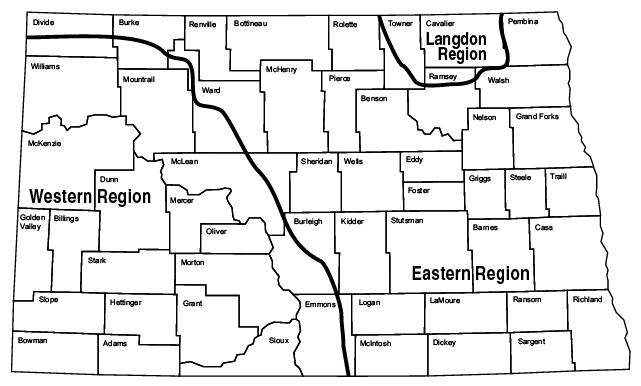The two most important amendments and cultural practices that have been shown to be effective in providing nutrients to small grains, including rye, are manure application and the use of green manures prior to seeding.
Table 2. Maximum N + K2O fertilizer rates with small-grain seed at planting based on row spacing, planter opener type and seedbed utilization (Deibert, 1986). SU = seedbed utilization.
| | | Row spacing, inches |
|---|
| | | 6 | | 7.5 | | 10 | | 12 |
|---|
| Planter opener type | Seed spread | SU | lb N+K2O/ acre | | SU | lb N+K2O/ acre | | SU | lb N+K2O/ acre | | SU | lb N+K2O/ acre |
|---|
| | inches | | | | | | | | | | | |
|---|
| Double-disc | 1 | 17% | 20-30 | | 13% | 19-28 | | 10% | 17-23 | | 8% | 15-20 |
| Hoe | 2 | 33% | 32-44 | | 27% | 27-38 | | 20% | 23-31 | | 17% | 20-27 |
| | 3 | 50% | 44-58 | | 40% | 37-48 | | 30% | 30-40 | | 25% | 26-34 |
| Airseeder | 4 | 66% | 56-72 | | 53% | 46-58 | | 40% | 37-48 | | 33% | 32-42 |
| | 5 | 83% | 68-86 | | 68% | 56-68 | | 50% | 44-57 | | 44% | 38-49 |
| | 6 | 100% | 80-100 | | 80% | 66-79 | | 60% | 51-55 | | 50% | 44-56 |
| | 7 | | | | 94% | 76-90 | | 70% | 58-74 | | 58% | 50-64 |
| | 8 | | | | | | | 80% | 66-83 | | 67% | 56-71 |
| | 9 | | | | | | | 90% | 73-92 | | 75% | 62-78 |
| | 10 | | | | | | | 100% | 80-100 | | 83% | 68-86 |
| | 11 | | | | | | | | | | 92% | 74-93 |
| | 12 | | | | | | | | | | 100% | 80-100 |
Fresh manure application provides higher N content relative to P, but it also has a higher weed-seed risk. Composted manures provide lower N content relative to P, but if the manure has been composted correctly, the viable weed seed concentration in the manure will be low.
Manure is desirable whenever possible in a rotation because it is the only practical way to increase the nonmobile nutrients in the soil that are taken away at harvest. Rotations may make some nutrients more available, such as P after buckwheat, but they do not increase the amount of nutrients in soil, with the exception of N from the legume-nitrogen relationship. Manures differ in their nutrient content (Table 3).
Table 3. Approximate plant nutrient value of selected types of manure (Wiederholt, 2004).
| Form of manure | N | P2O5 | K2O |
|---|
| | ——— lb nutrient/ton ——— |
| Beef – solid dirt lot – cows | 25 | 18 | 22 |
| Dairy – solid dirt lot – cows | 11 | 7 | 9 |
| Swine – solid, finishing | 13 | 13 | 9 |
| Sheep – solid | 20 | 13 | 27 |
| Poultry – turkey – solid | 55 | 63 | 40 |
| | ——— lb/1,000 gal ——— |
| Dairy – liquid – anaerobic storage | 22 | 14 | 20 |
| Swine – liquid – finishing | 27 | 19 | 15 |
| Source: “Determining Crop Available Nutrients from Manure.” G97-1335A. University of Nebraska Cooperative Extension |
Fresh manure also needs to be incorporated within a few hours of application to avoid loss of nitrogen as ammonia gas. The longer the manure sits undisturbed in the field, the less nitrogen will be available for crops later. Composted manure, however, can remain on the field undisturbed for much longer because much of its nitrogen already has been lost in the composting process. Sampling manure and having it tested for N, P and K content is suggested to better address crop nutrient needs.
Cover crops may provide N to a following rye crop if they are not N deficient themselves. Green-growing vegetation, regardless of whether they are legumes, most often contain at least 4 percent N. When this vegetation is incorporated into the soil, about one-third of the N often is released back into the soil during initial decomposition and can be used by plants.
Legumes are a preferred cover crop if given enough time to develop because they can add N to the cropping system through the activity of their symbiotic soil bacteria. Inoculation of legume seed is important before seeding for nitrogen fixation to occur.


